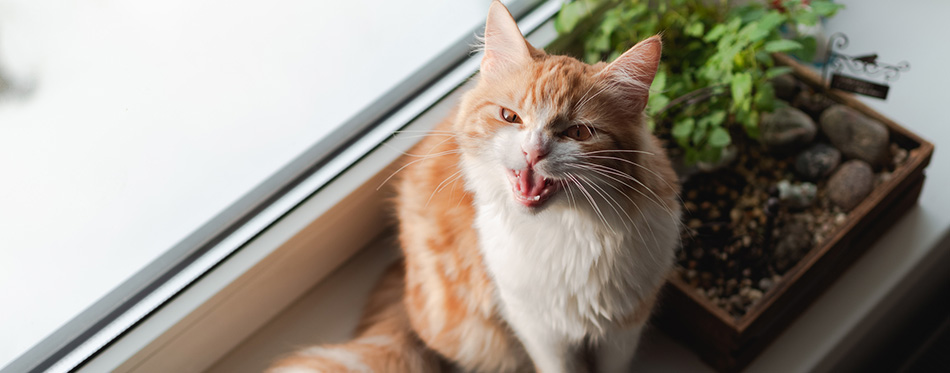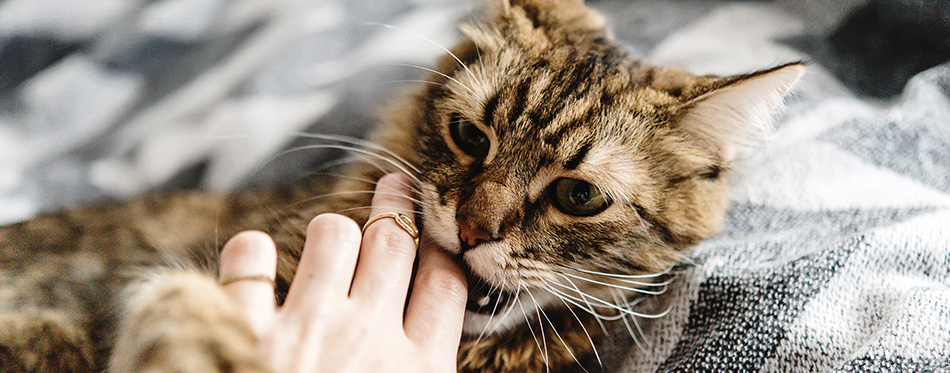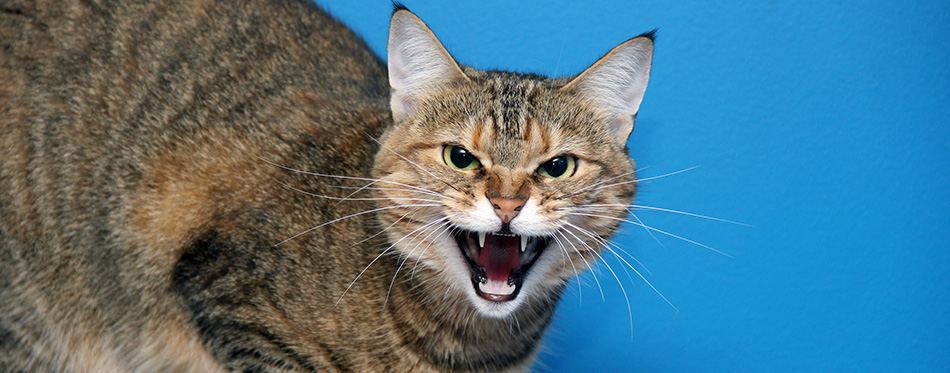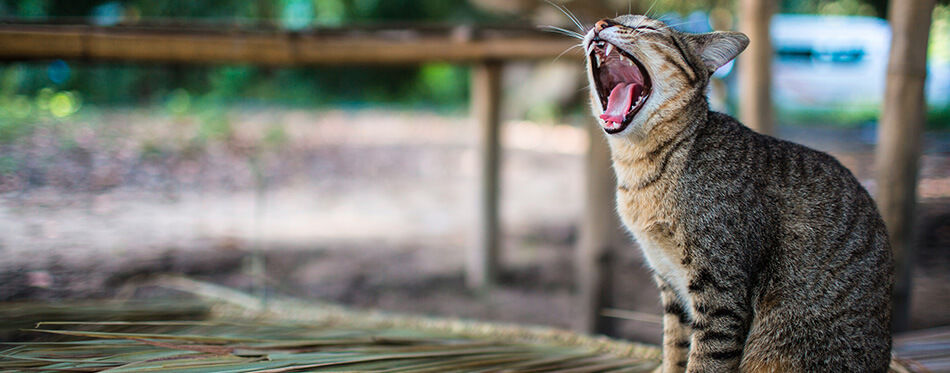While cats make wonderful family pets, there can be times when they may be a little grumpy. Usually this moody blip resolves itself, but sometimes a cat can show distinctly angry, even aggressive behavior. And that is not a good thing.
An aggressive cat can cause distress in your household, especially if you find yourself fearful of their hissing, clawing and biting as they try to get their point across. And so it’s important as pet parents to be able to recognize when your cat is not happy and know how to manage the potential causes of their aggression.
We’ve put together our top five ways to calm an angry cat so that you can bring peace and harmony back to your home.
Defining Aggression in Cats
The American Society for the Prevention of Cruelty to Animals or ASPCA defines aggression as any behavior that is either threatening or harmful. The recipient of the aggressive behavior can be a person, another cat, other pets, or other animals.
It is important to realize that thousands of years of domestication will never extinguish the animal instincts of cats. Man, for all his intellect and sense of right and wrong, is still prone to fits of aggression and violence. If a creature known for his rational behavior can still show aggressive tendencies, what more with animals?

Causes of Feline Aggression
There are many reasons why cats can display aggression. Some are defensive in nature, such as when a cat needs to protect its territory or its young kittens. There are also those forms of aggression that are offensive, such as a male cat establishing its dominance over another male cat. This behavior is not only restricted to domestic cats, however. All animals will display some form of aggression in one way or another. What is important now is to understand what can trigger a cat to become aggressive.
Predatory Aggression
This is a type of aggression that gets triggered by the cat’s predatory instincts. We all know that cats are the domesticated cousins of some of the fiercest beasts in the wild. They are exceptional hunters. And while the domestic cat will not hunt deer, an impala, or a gazelle, they are very proficient in hunting smaller prey.
Cats learn this behavior from their respective moms. As kittens, they need to watch how mommy cat stalks a potential prey before pouncing on it for the kill. They need to know how to hunt for food; otherwise, they will grow hungry and may die. Hence, at an early age, kittens know that they have to do everything they can to survive. They practice this predatory skill on their littermates.
A cat that is displaying predatory aggression may pounce on an unsuspecting individual. It can scratch and bite without provocation and without warning. Such a behavior is unfair to other pets in the household. They may not be doing anything wrong to provoke such an attack, but the cat does it anyway. It can also go the other way. If the cat displays predatory aggression towards a wrong prey like a snake, the cat may die.
Territorial Aggression
Cats are more or less solitary creatures. Mommy kitty taught them to look at the world this way. Mother cats always teach their kittens how to fend for themselves and how protecting one’s resources is crucial to their survival. In the wild, resources are scarce. There is not much food around. Wild cats have to hunt all day long if they do not want to starve.
While domestic cats have almost everything they can ask for, they still view this as “their” resources. The food you give them, the bed they sleep on, and the toys they play with are “theirs”. They also consider their human owners as “theirs”. They have this thinking that anything and anyone within the confines of their home is “theirs”. To the cat, this is its “territory”.
Territorial aggression in cats occurs when another cat enters a cat’s perceived territory. Stray cats that visit your backyard are examples of kitties that infringe the territory of your cat. The same is true when bringing home a new cat. The existing kitty may display territorial aggression towards the new cat. This is because it believes there is now competition for its resources.
You may also like our articles on Dry Cat Food and Wet Cat Food.
Play Aggression
Almost similar to predatory aggression, play aggression is quite common among kittens and cats that are less than 2 years old. Remember what we said about kittens having to practice what the mother cat taught them about being a predator? Well, they are practicing their predatory skills with their littermates. For us, it may look disturbing. But for kittens, it is normal.
The problem with play aggression is that kittens can extend this behavior to their human owners. When young children play with kittens, it is possible that the young cat will be quite aggressive towards the child. This can hurt the child. And while it is easy to think about punishing the kitten, it is not its fault.
On a more positive note, play aggression does tend to taper off as the kitty grows into an adult. However, keep in mind that this kind of aggression is often replaced by predatory aggression.
Fear Aggression
Fear can trigger the aggressive tendencies of cats. If a cat is scared or feels threatened, it may want to avoid confrontation. However, if it does not have any other choice, then the cat will have to be ready to lash out in an aggressive manner.
This is quite typical during veterinary visits. The cat may associate the trip with something that it dreads. You can also see fear aggression in cats that may have had a negative experience facing another cat or another person. Injured or sick cats can also display fear aggression. This is understandable since they may be protecting an injured or painful body part. They do not want you or anyone else to touch this sensitive part of their body.
Redirected Aggression
Cat fanciers say this is the most dangerous kind of feline aggression. The attacks are often uninhibited, damaging, and frightening. Many pet parents consider this as unprovoked aggression in cats.
Redirected aggression occurs because the cat cannot get back at something or someone that agitated the cat in the first place. For example, if another cat is present in the backyard and your cat sees it, it may want to attack the cat for “invading” its territory. Unfortunately, your kitty is inside your house and it cannot get out. This is frustrating for the kitty. Hence, it redirects its negative energies from the invading cat to something or someone else. That could mean you or any other member of the household.
Petting-Induced Aggression
Not all cats enjoy petting. That is why there are some that may look fine at first only to get up and scratch or bite the person petting it without warning. Feline behaviorists do not know the exact cause of this aggression in cats. It is possible that the cat being petted has reached its comfort threshold. It may no longer feel the petting action to be comfortable. Hence, it displays its aggressive tendencies towards the person petting it.
More often than not, the cat will show warning signs. It may twitch its tail or start looking around its surroundings. Some may also have their pupils dilated. If you see any of these signs while petting your cat, it’s your cue to stop what you are doing.
Intermale Aggression
This type of aggression is typical among tomcats or male cats. They fight among each other as to who among them is more dominant. This behavior is also heightened by the presence of a female cat in heat. There is competition as to which tomcat can get the female.

Medical Problems
Diseases, pain syndromes, and other feline health problems can also make a cat more aggressive. Rabies, hyperthyroidism, and liver disease can all produce aggression in cats. Pain syndromes related to arthritis, abscess, and dental and gum diseases can also trigger feline aggression. Other potential causes include feline ischemic encephalopathy, thiamine deficiency, and brain injury.
Symptoms of Feline Aggression
In learning how to deal with an aggressive cat, it is important to recognize the telltale and not-so-obvious signs of feline aggression. Animals communicate to us through their body language. Cat parents have to pay attention to both subtle and overt behavior that may already signal an impending aggression.
Aggression can manifest through a cat’s defensive or offensive postures. In general, an offensive-aggressive cat will try to make its look more intimidating.
- Stands upright with legs straight and stiff
- Rear legs are stiff with its rear end higher than its head
- Stiff tail that points straight down
- Upright ears
- Direct stare
- Constricted pupils
- Hackles up
- Faces opponent in a direct manner; may move towards its opponent
- Yowling, howling, or growling
A cat that is aggressive because it is in a defensive mode will try to look smaller. It will also adopt a posture that will protect itself.
- Head tucked in
- Crouching stance
- Eyes are wide open
- Dilated pupils
- Tail tucked in and curved around the cat’s body
- Ears flat on the cat’s head either sideways or backward
- Turns sideways to its opponent
- May “jab” or deliver quick strikes at opponents using its front paws
The above-mentioned manifestations of feline aggression are subtle compared to overt signs of aggression. The important thing to remember is that these signs are a cat’s message to you to leave it alone. Do not go anywhere near this cat. If you heed these subtle messages, then you will be able to save yourself from a nasty cat bite or cat scratches.
Overt aggression in cats can manifest through the following:
- Fighting
- Scratching
- Biting
- Shrieking or growling
- Striking with its paws
- Swatting
- Rolling onto its back or side to expose its claws and teeth
- Attempting to grab an opponent and draw it close to its mouth to bite it
These overt manifestations of feline aggression can occur in either a defensive or offensive cat.

How to Calm an Angry Cat
Once you have an idea as to what may be provoking your angry cat and you have ruled out a medical emergency, you can take the following steps to help resolve the situation:
Keep Calm and Don’t Punish
Whether it’s with another human or a cat, aggression does not solve aggression so be mindful of your body language, movements and tone of voice when approaching a wound-up cat. Cats do not respond well to anything negative, so yelling or punishing your kitty for their aggressive behavior is only going to make things worse. And escalating an already angry cat could lead to you getting hurt. So, when approaching an aggressive cat, keep your body small and don’t make any sudden movements, but walk up to them slowly, keeping your voice gentle, low and reassuring. Don’t deliberately corner an angry cat and if you can, offer something to divert them – their favorite toy, a treat or even a bowl of cat food.
Provide Them With a Safe Space
An aggressive cat is a stressed cat, so creating a safe space where they can calm down is essential. Remove anything in the immediate environment that may be agitating your kitty, including children or other pets and turn off the TV or radio to eliminate any loud noises.
Make sure their safe space familiar to them, is warm and has their bed or a comfortable space where they can seek out some privacy and take a little time to calm down, without the need to interact with you or have physical contact. For more options head over to our guides on cat beds and heated cat beds.
Separate Feuding Cats
If you have several cats, then sometimes they may simply not get along, especially if dominance and territory become an issue. Excessively aggressive cats can be dangerous to other felines, so any issues need to be resolved as soon as possible. If your cats are engaged in a fight, don’t physically step and intervene but make a loud noise to stop them in their tracks. Now leave them alone to calm down before approaching them. If the aggression in cats continues, you will need to separate them for a period before slowly reintroducing them. And this means a separate litter box, feeding/water bowls and sleeping spaces.

Provide Alternative Stimulation
In some cats, aggression can be a way for them to release up energy, especially if they are not getting enough exercise or stimulation in their day-to-day life. If your kit is starting to show signs of anger or aggressive behavior, providing them with alternative stimulation and activity can bring them back on a happier track. Scratching posts, perches, cat toys and cat condos are all good ways to provide your pet with the stimulation they need to direct their energy into more positive outcomes and prevent any unwanted behavior issues.
Take a look at our reviews of Cat Scratching Posts and Cat Window Perches.
When to Call for Veterinarian Help
If your efforts to calm your angry cat down are not working, you suspect a health issue, their aggression is out of character or comes on suddenly with no obvious cause, then a trip to the vet should be your priority.
A cat is not aggressive without reason, and your veterinarian will be able to give your pet a thorough check to rule out any underlying medical condition. Even if your veterinarian cannot find a physical cause, they will be able to advise as to ways to help resolve your feline’s aggression. They may also recommend the intervention of animal behaviorists, who will work with you to devise appropriate strategies and training tips to modify that angry cat behavior and return your house to a happy cat home.
Sources:
- Aggression in Cats (Overview) – PetMD
- Aggression in Cats – ASPCA
- Aggression between cats – The Humane Society

